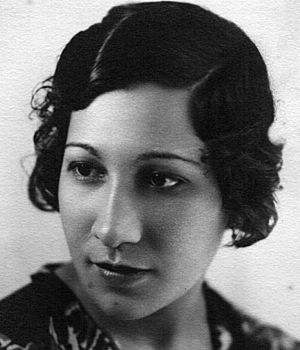Cacilda Borges Barbosa facts for kids
Cacilda Campos Borges Barbosa (born May 18, 1914 – died August 6, 2010) was a Brazilian musician. She was a skilled pianist, a leader of musical groups (a conductor), and a composer who wrote music. She was also one of the first people to create electronic music in Brazil.
Her Life and Music
Cacilda Barbosa was born in Rio de Janeiro, Brazil. In 1928, she started studying music at the National Institute of Music in Rio de Janeiro. There, she learned from famous teachers like Antônio Francisco Braga and Oscar Lorenzo Fernandez.
After finishing her studies, Cacilda worked as a pianist. She played popular Brazilian dance music like waltzes and chorinhos for dance groups. She also wrote new music for them.
In the 1950s, she published her first book of "Brazilian Studies for Singing." She also became the conductor for the Radio Mayrink Veiga orchestra. This meant she led the musicians in the orchestra.
Cacilda Barbosa worked closely with the famous Brazilian composer Heitor Villa-Lobos starting in 1930. She even became the director of the Instituto Villa-Lobos, which was named after him.
She also taught music at universities. She was a professor at the National School of Music at the University of Brazil. She taught subjects like counterpoint and fugue, which are advanced ways of writing music. She also led many orchestras and choirs.
Her Musical Compositions
Cacilda Barbosa wrote many musical pieces. A lot of her music had a strong Brazilian feel. She composed pieces for large groups of instruments (called orchestral music) and for smaller groups (called chamber music). She also wrote music to help piano students learn.
Here are some of her well-known works:
- Procissão da Chuva (Procession of the Rain) – based on a poem by Wilson Rodrigues
- Estudos Brasileiros (Brazilian Studies)
- Trio for Reeds
- Rio de Janeiro Suite for strings (1st mov)
- Rio de Janeiro Suite for strings (2nd mov)
- Little Entrance Music
See also
 In Spanish: Cacilda Borges Barbosa para niños
In Spanish: Cacilda Borges Barbosa para niños


